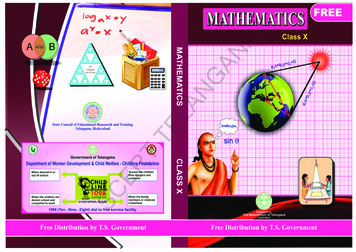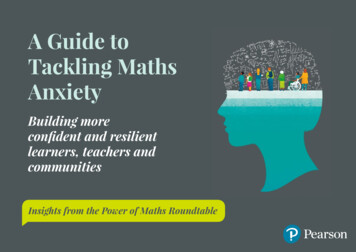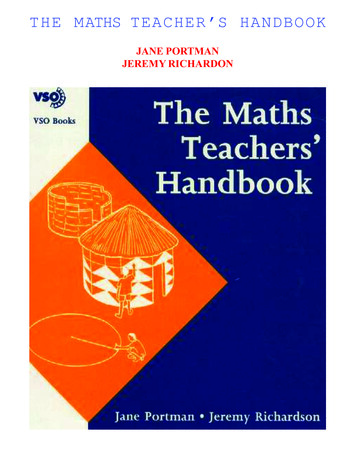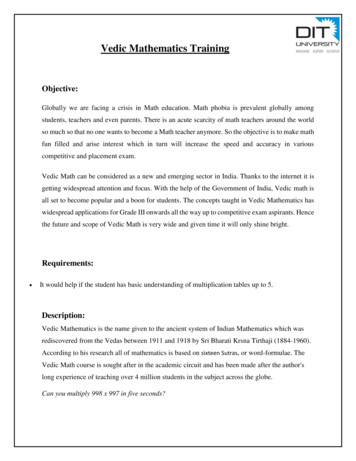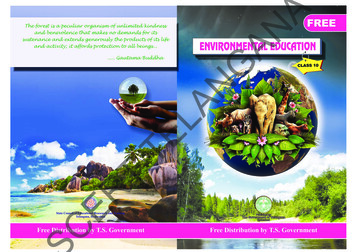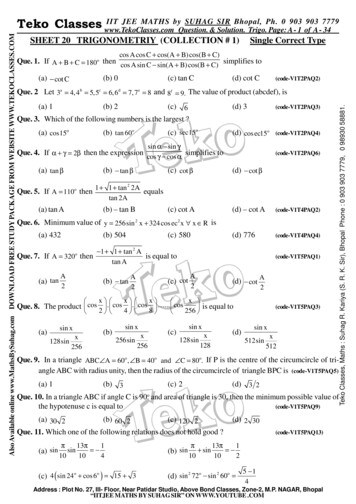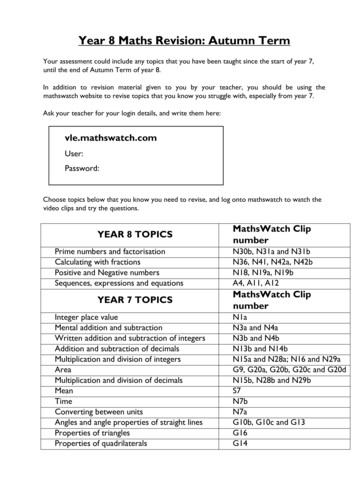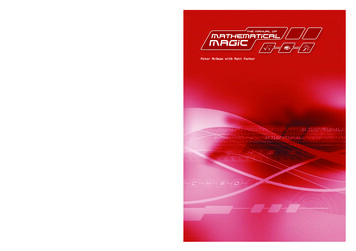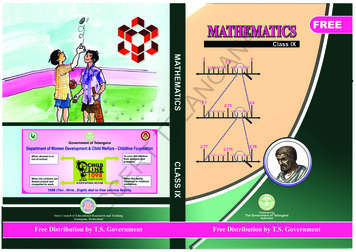
Transcription
TERSCNGLATEANA
While understanding the concepts through activities, some doubts may arise.Clarify those doubts by through discussion with your friends and teachers,understand the mathematical concepts without any doubts. ''Do this/Do these" exercises are given to test yourself, how far the concept hasbeen understood. If you are facing any difficulty in solving problems in theseexercises, you can clarify them by discussing with your teacher. The problems given in "Try this/try these", can be solved by reasoning, thinkingcreatively and extensively. When you face difficulty in solving these problems,you can take the help of your friends and teachers. The activities or discussion points given "Think and disicuss" have been givenfor extensive understanding of the concept by thinking critically. These activitiesshould be solved by discussions with your fellow students and teachers. Different typs of problems with different concepts discussed in the chapter aregiven in an "Exercise" given at the end of the concept/chapter. Try to solve theseproblems by yourself at home or leisure time in school. The purpose of "Do this"/do these", and "Try this/try these" exercises is to solveproblems in the presence of teacher only in the class itself. Wherever the "project works" are given in the textbook, you should completethem in groups. But the reports of project works should be submitted individually. Try to solve the problems given as homework on the day itself. Clarify yourdoubts and make corrections also on the day itself by discussions with yourteachers. Try to collect more problems or make new problems on the concepts learnt andshow them to your teachers and fellow students. Try to collect more puzzles, games and interesting things related to mathematicalconcepts and share with your friends and teachers. Do not confine mathematical conceptual understanding to only classroom. But,try to relate them with your suroundings outside the classroom. Student must solve problems, give reasons and make proofs, be able tocommunicate mathematically, connect concepts to understand more concepts &solve problems and able to represent in mathematics learning. Whenever you face difficulty in achieving above competencies/skills/standards,you may take the help of your teachers.NGFor each and every conceptual understanding, a real life context with appropriateillustrations are given in the textbook. Try to understand the concept through keenreading of context along with observation of illustration.SCERTTELA ANACHILDREN! THESE DIINSTRUCTIONS FOR YOU.
ANAMATHEMATICSCLASS - IXTEXTBOOK DEVELOPMENT & PUBLISHING COMMITTEE:Sri. A. Satyanarayana Reddy,Director, SCERT, Hyderabad.Executive Chief Organiser:Sri.B. Sudhakar,Director, Govt. Text Book Press, Hyderabad.Organising Incharge:LANGChief Production OfficerTEDr. Nannuru Upender Reddy,Prof. & Head, Curriculum & Text Book Department,SCERT, Hyderabad.Chairperson for Position Paper and Mathematics Curriculum and Textbook DevelopmentProf. V.Kannan,Department of Mathematics and Statistics,Hyderabad Central University, HyderabadChief AdvisorsDr. H.K.DewanEminent Scholar in MathematicsTelangana, Hyderabad.Educational Advisor, Vidya Bhawan SocietyUdaipur, RajasthanSCERTSri Chukka RamaiahPublished byThe Government of Telangana, HyderabadRespect the LawGrow by EducationGet the RightsBehave HumblyFREE DISTRIBUTION BY T.S. GOVERNMENT 2019-20
ANA Government of Telangana, Hyderabad.NGFirst Published 2013New Impressions 2014, 2015, 2017,2018, 2019All rights reserved.TELANo part of this publication may be reproduced,stored in a retrieval system, or transmitted, in anyform or by any means without the prior permission inwriting of the publisher, nor be otherwise circulatedin any form of binding or cover other than that inwhich it is published and without a similar conditionincluding this condition being imposed on the subsequent purchaser.The copy right holder of this book is the Directorof School Education, Hyderabad, Telangana.SCERTThis Book has been printed on 70 G.S.M. Maplitho TitlePage 200 G.S.M. White Art CardFree distribution by Telangana Government 2019-20Printed in Indiaat Telangana Govt. Text Book Press,Mint Compound, Hyderabad,Telangana.–– o ––(ii)FREE DISTRIBUTION BY T.S. GOVERNMENT 2019-20
AText Book Development CommitteeNGANWritersSri. Tata Venkata Rama KumarSri. Gottumukkala V.B.S.N. RajuH.M., ZPPHS, Mulumudi, Nellore Dt.SA, Mpl. High School, Kaspa, Vizianagaram.Sri. Soma Prasad BabuSri. K.Varada Sunder ReddyPGT. APTWRS, Chandrashekarapuram, NelloreSA, ZPHS,Thakkasila, Alampur Mandal Mahabubnagar Dt.Sri. Komanduri Murali SrinivasSri. Abbaraju KishorePGT.APTWR School of Excellence, Srisailam.SGT, MPUPS,Chamallamudi, Guntur Dt.Sri. Padala Suresh KumarSri. G. Anantha ReddySA,GHS, Vijayanagar Colony, Hyderabad.Retd. Headmaster, Ranga Reddy Dt.Sri. P.D.L. Ganapati SharmaSri. M. RamanjaneyuluSA,GHS, Zamisthanpur, Manikeshwar Nagar, Hyd.Sri. M. Rama CharyLASri. Duggaraju VenuLecturer, Govt D.I.E.T., Vikarabad, R.R. Dt.SA,UPS, Allawada, Chevella Mandal, R.R. Dt.Lecturer,Govt D.I.E.T., Vikarabad, R.R. Dt.Sri. P. Anthony ReddyDr. A. RambabuH.M.,St. Peter’s High School, R.N.Peta, Nellore.Dr. Poondla RameshTESri D. ManoharLecturer, Government CTE, WarangalSA, ZPHS, Brahmanpally, Tadwai (Mandal) Nizamabad Dt.Lecturer, Government lASE, NelloreEditorsProf. N.Ch.Pattabhi Ramacharyulu (Retd.)Sri. K BrahmaiahProfessor, Dept. of Statistics,SCERT, HyderabadNational Institute of Technology,Warangal.(Retd.)Prof., SCERT, HyderabadProf. V. Shiva RamaprasadSri A. PadmanabhamDr. G.S.N. Murthy (Retd.)(Retd.)Dept. of Mathematics,Osmania University, Hyderabad(Retd.)H.O.D of MathematicsMaharani College, PaddapuramReader in MathematicsRajah R.S.R.K.R.R College, BobbiliERTDr. S Suresh BabuCo-ordinatorsSri Kakulavaram Rajender ReddySri K.K.V RayaluResource Person, SCERT, HyderabadLecturer, IASE, Masab Tank, HyderabadSCSri Inder MohanAcademic Support Group MembersSri Yashwanth Kumar DaveSri Sharan GopalSri Hanif Paliwal Sri Asish ChordiaVidyabhawan Society Resource Centre, UdaipurKum M. ArchanaSri P. ChiranjeeviDepartment of mathematics and Statistics, University of HyderabadSri Prasanth SoniIllustrations and Design TeamSri Sk. Shakeer AhmadSri S. M. IkramVidyabhawan Society Resource Centre, UdaipurCover Page DesigningSri. K. Sudhakara Chary, HM, UPS Neelikurthy, Mdl.Maripeda, Dist. Warangal(iii)FREE DISTRIBUTION BY T.S. GOVERNMENT 2019-20
AForewordNGANEducation is a process of human enlightenment and empowerment. Recognizing theenormous potential of education, all progressive societies have committed themselves to theUniversalization of Elementary Education with an explicit aim of providing quality educationto all. As the next step, universalization of Secondary Education has gained momentum.The secondary stage marks the beginning of the transition from functional mathematicsstudied upto the upper primary stage to the study of mathematics as a discipline. The logicalproofs of propositions, theorems etc. are introduced at this stage. Apart from being a specificsubject, it is to be treated as a concommitant to any subject involving analysis as reasoning.I am confident that the children in our state of Telangana learn to enjoy mathematics,make mathematics a part of their life experience, pose and solve meaningful problems,understand the basic structure of mathematics by reading this text book.TELAFor teachers, to understand and absorb critical issues on curricular and pedagogicperspectives duly focusing on learning in place of marks, is the need of the hour. Also copingwith a mixed class room environment is essentially required for effective transaction of curriculumin teaching learning process. Nurturing class room culture to inculcate positive interest amongchildren with difference in opinions and presumptions of life style, to infuse life into knowledgeis a thrust in the teaching job.The afore said vision of mathematics teaching presented in State Curriculum Framework (SCF -2011) has been elaborated in its mathematics position paper which also clearlylays down the academic standards of mathematics teaching in the state. The text books makean attempt to concretize all the sentiments.SCERTThe State Council for Education Research and Training Telangana appreciates the hardwork of the text book development committee and several teachers from all over the statewho have contributed to the development of this text book. I am thankful to the DistrictEducational Officers, Mandal Educational Officers and head teachers for making this possible.I also thank the institutions and organizations which have given their time in the developmentof this text book. I am grateful to the office of the Commissioner and Director of SchoolEducation (T.S.) and Vidya Bhawan Society, Udaipur, Rajastan for extending co-operation indeveloping this text book. In the endeavor to continuously improve the quality of our work,we welcome your comments and suggestions in this regard.Place : HyderabadDate : 03 December 2012DirectorSCERT, Hyderabad(iv) FREE DISTRIBUTION BY T.S. GOVERNMENT 2019-20
APrefaceNGANThe Government of Telangana has decided to revise the curriculum of all the subjectsbased on State Curriculum Frame work (SCF - 2011) which recommends that children’s lifeat schools must be linked to their life outside the school. Right to Education (RTE - 2009)perceives that every child who enters the school should acquire the necessary skills prescribedat each level upto the age of 14 years. The introduction of syllabus based on NationalCurriculum Frame Work - 2005 is every much necessary especially in Mathematics andSciences at secondary level with a national perspective to prepare our students with a strongbase of Mathematics and Science.The strength of a nation lies in its commitment and capacity to prepare its people tomeet the needs, aspirations and requirements of a progressive technological society.LAThe syllabus in Mathematics for three stages i.e. primary, upper primary and secondaryis based on structural and spiral approaches. The teachers of secondary school Mathematicshave to study the syllabus of classes 8 to 10 with this background to widen and deepen theunderstanding and application of concepts learnt by pupils in primary and upper primarystages.TEThe syllabus is based on the structural approach, laying emphasis on the discovery andunderstanding of basic mathematical concepts and generalisations. The approach is to encouragethe pupils to participate, discuss and take an active part in the classroom processes.The present text book has been written on the basis of curriculum and Academic standardsemerged after a thorough review of the curriculum prepared by the SCERT.The syllabus has been divided broadly into six areas namely, Number System, Algebra,Geometry, Measuration, Statistics and Coordinate Geometry. Teaching of the topicsrelated to these areas will develop the skills prescribed in academic standards such asproblem solving, logical thinking, mathematical communication, representing data invarious forms, using mathematics as one of the disciplines of study and also in daily lifesituations.ERT SCThe text book attempts to enhance this endeavor by giving higher priority and space toopportunities for contemplations. There is a scope for discussion in small groups andactivities required for hands on experience in the form of ‘Do this’ and ‘Try this’. Teacher’ssupport is needed in setting the situations in the classroom.Some special features of this text book are as follows The chapters are arranged in a different way so that the children can pay interest to allcurricular areas in each term in the course of study.Teaching of geometry in upper primary classes was purely an intuition and to discoverproperties through measurements and paper foldings. Now, we haveFREE DISTRIBUTION BY T.S. GOVERNMENT 2019-20(v)
ERTTELANGANAstepped into an axiomatic approach. Several attempts are made through illustrations to understand,defined, undefined terms and axioms and to find new relations called theorems as a logicalconsequence of the accepted axioms.Care has been taken to see that every theorem is provided initially with an activity for easyunderstanding of the proof of those theorems. Continuous Comprehension Evaluation Process has been covered under the tags of ‘Trythis’ and ‘Think, Discuss and Write’. Exercises are given at the end of each sub item of thechapter so that the teacher can assess the performance of the pupils throughout the chapter. Entire syllabus is divided into 15 chapters, so that a child can go through the content well inbit wise to consolidate the logic and enjoy the learning of mathematics. Some interesting and historical highlights are given under titles of Brain teasers, Do youknow will certainly help the children for creative thinking. Colourful pictures, diagrams, readable font size will certainly help the children to adopt thecontents and care this book as theirs.Chapter (1) Real Numbers under the area number system and irrational numbers in detail.Thechild can visualise the rational and irrational numbers by the representation of them on numberline. Some history of numbers is also added e.g value of to create interest among students. Therepresentation of real numbers on the number line through successive magnification help tovisualise the position of a real number with a non-terminating recurring decimal expansion.Chapter (2) Polynomials and Factorisation under the area algebra dealt with polynomials in onevariable and discussed about how a polynomial is diffierent from an algebraic expression.Facrtorisation of polynomials using remainder theorem and factors theorem is widely discussedwith more number of illustrations . Factorisation of polynomials were discussed by splitting themiddle term with a reason behind it. We have also discussed the factorisation of some specialpolynomials using the identities will help the children to counter various tuypes of factorisation.Chapter (3) Linear equations in two variables under the same area will enable the pupil todiscover through illustative examples,the unifying face of mathematical structure which is theultimate objective of teaching mathematics as a system. This chapter links the ability of findingunknown with every day experience.SCThere are 7 chapters of Geometry i.e (3 ,4,7,8,11,12, and 13 ) were kept in this book. All thesechapters emphasis learning geometry using reasoning , intutive understanding and insightfulpersonal experience of meanings. It helps in communicating and solving problems and obtainingnew relations among various plane figures. Development geometry historically through centuriesis given and discussed about Euclid’s contribution in development of plane geometry through hiscollection “The Elements” . The activities and theorem were given on angles, triangles, quadrilaterals, circles and areas. It will develop induction, deduction, analytical thinking and logical reasoning.Geometrical constructions were presented insuch a way that the usage of an ungraduated rulerand a compass are necessary for a perfect construction of geometrical figures.(vi)FREE DISTRIBUTION BY T.S. GOVERNMENT 2019-20
ERTTELANGANAChapter (5) deals with coordiante geometry as an alternate approach to Euclidean geometryby means of a coordinate system and associated algebra. Emphasis was given to plotordered pairs on a cartesian plane ( Graph ) with a wide variety of illustratgive examples.Chapter (9) statistics deals with importance of statistics , collection of statistical data i.egrouped and ungrouped , illustrative examples for finding mean, median and mode of agiven data was discussed by taking daily life sitution.Chapter (14) Probability is entirely a new chaper for secondary school students wasintroduced with wide variety of examples which deals with for finding probable chances ofsuccess in different fields. and mixed proportion problems with a variety of daily life situations.Chapter (10) surface areas and volumes we discussed about finding curved (lateral) surfacearea, total surface area and volume of cylinder, cone and sphere. It is also discussed therelation among these solids in finding volumes and derive their formulae.Chapter (15) Proofs in mathematics will help ;the students to understand what is amathematical statement and how to prove a mathematical statement in various situations.We have also discussed about axiom , postulate, conjecture and the various stages in provinga theorem with illustrative examples. Among these 15 chapters the teacher has to RealNumbers, Polynomials and Factorisation, Co-ordinate geometry, Linear equation in twovariables, Triangles, Quadrilaters and Areas under paper - I and the elements of Geometry,lines and angles, Statistics, Surface as a part of are volume, Circles Geometrical constructionsand probability under paper - II.The success of any course depends not so much on the syllabus as on the teacher and theteaching methods she employs. It is expected that all concerned with the improving ofmathematics education would extend their full co operation in this endeavour.Mere the production of good text books does not ensure the quality of education, unlessthe teachers transact the curriculum the way it is discussed in the text book. The involvementand participation of learner in doing the activities and problems with an understanding isensured. Therefore it is expected that the teachers will bring a paradigm shift in the classroomprocess from mere solving the problems in the exercises routinely to the conceptualunderstanding, solving of problems with ingenity.SCText Book development committeeFREE DISTRIBUTION BY T.S. GOVERNMENT 2019-20(vii)
Highlights from HistoryANA“The Wonder of Discovery is especially keen in childhood”How a child become Ramanujan a great mathematician of all the time?NGSrinivasa Ramanujan was the one who never lost his joy at learningsomething new. As a boy he impressed his classmates, senior students andteachers with his insight and intuition.One day in an Arithmetic class on 3 9 1 8division the teacher said that if three bananas 1 (2 4)were given to three boys, each boy wouldget a banana and he generalised this idea. 1 2 16Then Ramanujan asked “Sir, if no banana isdistributed to no student will every one still 1 2 1 15get a banana?”1 1 2 1 4 2 222TE1 1 (2 3) 2 4 2 Ramanujan’s math ability 1 2 1 (3 5)won several friends to him. Oncehis senior student posed a and so on .problem “Ifx y 7 andx y 11 , what are x and y”. Immediately Ramanujanreplied x 9 and y 4. His senior was impressed and becamea good friend to him.LARamanujan1 1 (2 3 5) 5 4 2 SCERTIn his school days, along with school homeworks,Ramanujan worked with some patterns out of his interest.21 1 Srinivasa Aaiyangar Ramanujan is undoubtedly the most (2 3 5 7) 14 4 2 celebrated Indian Mathematical genius. He was born in a poorfamily at Erode in Tamilnadu on December 22, 1887. Largely. and so onself taught, he feasted on “Loney’s Trigonometry” at the ageof 13, and at the age of 15, his senior friends gave him synopsis of Elementary results in pure andApplied mathematics by George Carr. He used to write his ideas and results on loose sheets.His filled note books are now famous as “Ramanujan’s Frayed note books”. Though he hadno qualifying degree, the university of Madras granted him a monthly Scholarship of Rs. 75 in1913. He had sent papers of 120 theorems and formulae to great mathematican G.H. Hardy(Combridge University, London). They have recognised these as a worth piece and invited himto England. He had worked with Hardy and others and presented numerical theories on numbers,which include circle method in number theory, algebra inequalities, elliptical functions etc. He wassecond Indian to be elected fellow of the Royal Society in 1918. He became first Indian electedfellow of Trinity college, Cambridge. During his illness also he never forget to think about numbers.He remarked the taxi number of Hardy, 1729 is a singularly unexceptional number. It is thesmallest positive integer that can be represented in two ways by the sum of two cubes; 1729 13 123 93 103. Unfortunately, due to tuberculosis he died in Madras on April 26, 1920.Government of India recognised him and released a postal stamp and declared 2012 as “Year ofMathematics” on the eve of his 125th birth anniversary.FREE DISTRIBUTION BY T.S. GOVERNMENT 2019-20
CONTENTSChapterContentsSyllabus to beCovered during1Real Numbers2Polynomials and Factorisation3The Elements of Geometry4Lines and Angles5Co-Ordinate Geometry6Page No.NGANNo.A{df¶-gyMrJune1-26June, July27-58July59-70August71-106107-123Linear Equations in Two variablesAugust, September124-1477TrianglesOctober, isticsJuly194-21310Surface areas and esJanuary260-27913Geometrical 92-30915Proofs in DecemberPaper - I : Real Numbers, Polynomials and Factorisation, Coordinate Geometry, Linear Equationin two variables, Triangles, Quadrilaterals and Areas.Paper - II : The Elements of Geometry, Lines and Angles, Statistics, Surface areas and Volumes,Circles, Geometrical Constructions and Probability.(ix)FREE DISTRIBUTION BY T.S. GOVERNMENT 2019-20
ANAOUR NATIONAL ANTHEM- Rabindranath TagoreJana-gana-mana-adhinayaka, jaya GangaUchchala-Jaladhi-taranga.LATava shubha name jage,Tava shubha asisa mage,Gahe tava jaya gatha,TEJana-gana-mangala-dayaka jaya heBharata-bhagya-vidhata.Jaya he, jaya he, jaya he,SCERTJaya jaya jaya, jaya he!PLEDGE- Pydimarri Venkata Subba Rao“India is my country. All Indians are my brothers and sisters.I love my country, and I am proud of its rich and varied heritage.I shall always strive to be worthy of it.I shall give my parents, teachers and all elders respect,and treat everyone with courtesy. I shall be kind to animalsTo my country and my people, I pledge my devotion.In their well-being and prosperity alone lies my happiness.”(x)FREE DISTRIBUTION BY T.S. GOVERNMENT 2019-20
ANAReal Numbers011.1 INTRODUCTIONNGLet us have a brief review of various types of numbers.Consider the following numbers. 5 213 69 221313,,,,7, 100, 9, 11, -3, 0, , 5, 1, , 1, 0.12, , 13.222 ., 19,7 5.6344171737N7, 7,9,0,10,10011, .ERT7,7,8,100100,101TELAJohn and Sneha want to label the above numbers and put them in the bags theybelong to. Some of the numbers are in their respective bags. Now you pick up rest of thenumbers and put them into the bags to which they belong. If one number can go in morethan one bag then copy the number and put them in the relevent bags.W-9,0, -10,7, 3,3, 70, 1,100Z3 0, 7,, 9, 7,7100, -3,-2,-3QYou have observed bag N contains natural numbers. Bag W contains whole numbers.Bag Z contains integers and bag Q contains rational numbers.SCThe bag Z contains integers which is the collection of negative numbers and wholenumbers. It is denoted by I or Z and we write,Z {. 3, 2, 1, 0, 1, 2, 3, }pwhere p and q areSimilarly the bag Q contains all numbers that are of the formqintegers and q 0.You might have noticed that natural numbers, whole numbers, integers and rationalpnumbers can be written in the form , where p and q are integers and q 0.q
IX-CLASS MATHEMATICSFor example, -15 can be written as 15; here p -15 and q 1. Look at the Example1A2NGAN12 1050 . and so on. These are equivalent rational numbers (or fractions). It2420 100pmeans that the rational numbers do not have a unique representation in the form , whereqpp and q are integers and q 0. However, when we say q is a rational number or when werepresenton a number line, we assume that q 0 and that p and q have no common factorsother than the universal factor ‘1’ (i.e., p and q are co-primes.) There are infinitely many fractions11equivalent to , we will choose i.e., the simplest form to represent all of them.22LAYou know that how to represent whole numbers on the number line. We draw a line andmark a point ‘0’ on it. Then we can set off equal distances on the right side of the point ‘0’ andlabel the points of division as 1, 2, 3, 4, TE0The integer number line is made like this,1234Do you remember how to represent the rational numbers on a number line? 5 4 3 2 1TTo recall this, let’s first take the fraction0123453and represent it pictorially as well as on number line.43, 3 is the numerator and 4 is the denominator.4Which means that 3 parts are taken out of 4 equal parts from a given unit.ERWe know that inSCHere are few representations of343.412344444-1(Pictorially)3401212(Number line)FREE DISTRIBUTION BY T.S. GOVERNMENT 2019-20
Example-1. RepresentSolution :55and on the number line.333ANAREAL NUMBERSDraw an integer line representing 2, 1, 0, 1, 2.-7 -2 -53 ( -6 ) 33-4 -1 -23 ( -3 ) 33-130132143 ( 3 ) 335273 ( 6 ) 33NGDivide each unit into three equal parts to the right and left sides of zero respectively.Take five parts out of these. The fifth point on the right of zero representsDO THIS 5.3LAone to the left of zero represents5and the fifth3p 3on the number line. 2. Write 0, 7, 10, -4 inform.q43. Guess my number : Your friend chooses an integer between 0 and100. You have to find out that number by asking questions, but yourfriend can answer only in ‘yes’ or ‘no’. What strategy would youuse?TE1. RepresentExample-2. Are the following statements True? Give reasons for your answers with anexample.Ti. Every rational number is an integer.ii. Every integer is a rational numberSCERiii. Zero is a rational number7Solution : i.False: For example,is a rational number but not an integer.8pii. True: Because any integer can be expressed in the form (q 0) for exampleq 2 4-2 . Thus it is a rational number.12b(i.e. any integer ‘b’ can be represented as )10 0 0 piii. True: Because 0 can be expressed as , , ( form, where p, q are integers2 7 13 qand q 0)(‘0’ can be represented asFREE DISTRIBUTION BY T.S. GOVERNMENT 2019-200where ‘x’ is an integer and x 0)x
IX-CLASS MATHEMATICSExample-3. Find two rational numbers between 3 and 4 by mean method.A4NGANSolution :Method-I : We know that the rational number that lies between two rational numbersa b.2a bHere a 3 and b 4, (we know thatis the mean of two integers ‘a’, ‘b’ and it2lies between ‘a’ and ‘b’)a and b can be found using mean method i.e.So,(3 4) 77 which is in between 3 and 4. 3 4222If we continue the above process, we can find many more rational numbers between 3 and72TELA3 72 6 27 13213 13 222 2 2 413 73 44 2Method-II : The other option to find two rational numbers in single step.Since we want two numbers, we write 3 and 4 as rational numbers with denominator 2 1 34812 16369 and 4 123123 410 11,Then you can see thatare rational numbers between 3 and 4.3 39 10 11 12 43 3 33 3Now if you want to find 5 rational numbers between 3 and 4, then we write 3 and 4as rational number with denominator 5 1 6.ERTi.e., 3 i.e. 3 1824and 4 663 18 19 20 21 22 23 24 , , , , 46 6 6 6 6 6 6SCFrom this, you might have realised the fact that there are infinitely many rationalnumbers between 3 and 4. Check, whether this holds good for any other two rationalnumbers? Thus we can say that , there exist infinite number of rational numbers betweenany two given rational numbers.DO THISi. Find any five rational numbers between 2 and 3 using mean method.83ii. Find any 10 rational numbers between and .1111FREE DISTRIBUTION BY T.S. GOVERNMENT 2019-20
Solution :7 10,and 2 in decimal form.16 73NGANExample-4. Express0.437516 80010 1.4285717is a non-terminatingrecurring decimalTE7 0.4375160.6663 2.0000181.4285717 1070 5AREAL NUMBERSis a terminating decimal50491072 0.666 0.63is a non-terminatingrecurring decimal 3From above examples, we notice that every rational number can be expressed as aterminating decimal or a non terminating recurring decimal.TDO THIS117ERExpress (i)(ii)1in decimal form.19Example -5. Express 3.28 in the form ofSCSolution :3.28 p(where p and q are integers, q 0 ).q328100 328 2 164 100 2 50 164 2 82 50 2 25 3.28 8225FREE DISTRIBUTION BY T.S. GOVERNMENT 2019-20(Numerator and denominator are co-primes)
6IX-CLASS MATHEMATICSSolutions : Let x 1.626262.ANApExample-6. Express 1.62 inform where q 0 ; p, q are integers.q(1)multiplying both sides of equation (1) by 100, we get100x 162.6262.(2)100x 162.6262.x -1.6262.-99x 161 1.62 16199TE LA16199xNGSubtracting (2) from (1) we getTRY THESEI. Find the decimal values of the following:12ii.122iii.15iv.15 2vii.13viii.76Ti.310vi.2725512x.17ERv.ix.Observe the following decimalsSC1 0.521 0.11032 6.451 0.333 .34 0.2615Can you guess the character of the denominator of a fraction which can be in theform of terminating decimal?Write prime factors of denominator of each rational number.What did you observe from the results?FREE DISTRIBUTION BY T.S. GOVERNMENT 2019-20
7ANAREAL NUMBERSEXERCISE - 1.1XERCISE1. (a) Write any three rational numbers(b) Explain rational number in your own words.2. Give one example each to the following statements.i. A number which is rational but not an integerNGii. A whole number which is not a natural numberiii. An integer which is not a whole numberiv. A number which is natural number, whole number, integer and rational number.v. A number which is an integer but not a natural number.3. Find five rational numbers between 1 and 2.5. Represent32and53LA4. Insert three rational numbers between8 8andon the number line5523ii) 2536iii)227iv)119pform where q
Wherever the "project works" are given in the textbook, you should complete them in groups. But the reports of project works should be submitted individually. Try to solve the problems given as homework on the day itself. Clarify your doubts and make corrections
